technical specification FIAT FREEMONT 2012 Owner handbook (in English)
[x] Cancel search | Manufacturer: FIAT, Model Year: 2012, Model line: FREEMONT, Model: FIAT FREEMONT 2012Pages: 332, PDF Size: 5.61 MB
Page 218 of 332
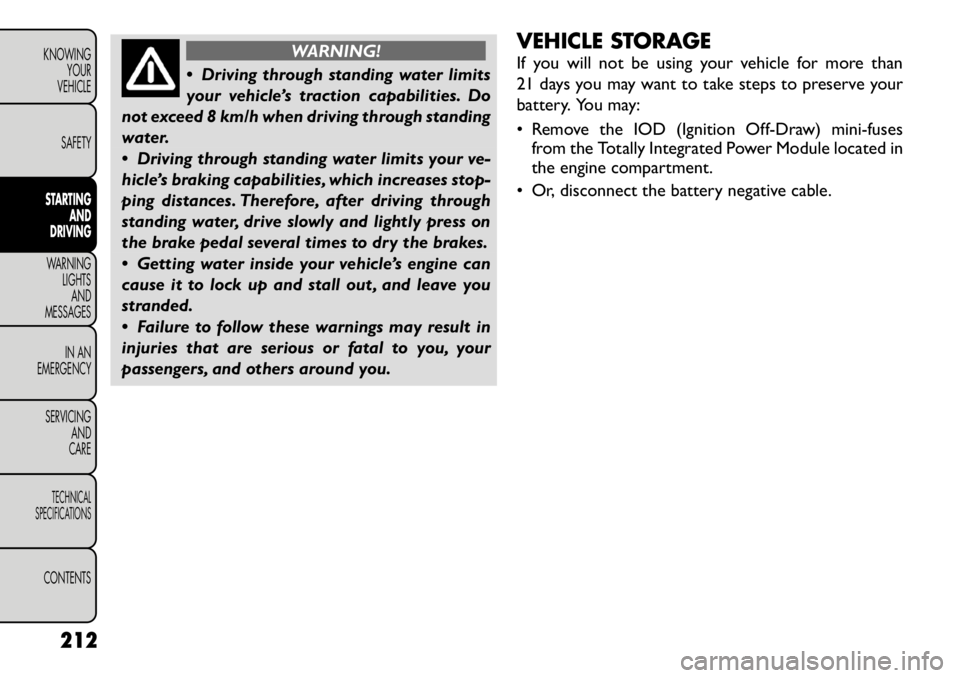
WARNING!
Driving through standing water limits
your vehicle’s traction capabilities. Do
not exceed 8 km/h when driving through standing
water.
Driving through standing water limits your ve-
hicle’s braking capabilities, which increases stop-
ping distances. Therefore, after driving through
standing water, drive slowly and lightly press on
the brake pedal several times to dry the brakes.
Getting water inside your vehicle’s engine can
cause it to lock up and stall out , and leave you
stranded.
Failure to follow these warnings may result in
injuries that are serious or fatal to you, your
passengers, and others around you. VEHICLE STORAGE
If you will not be using your vehicle for more than
21 days you may want to take steps to preserve your
battery. You may:
• Remove the IOD (Ignition Off-Draw) mini-fuses
from the Totally Integrated Power Module located in
the engine compartment.
• Or, disconnect the battery negative cable.
212
KNOWING YOUR
VEHICLE
SAFETYSTARTING AND
DRIVINGWARNING LIGHTSAND
MESSAGES
IN AN
EMERGENCY
SERVICING AND
CARETECHNICAL
SPECIFICATIONSCONTENTS
Page 219 of 332
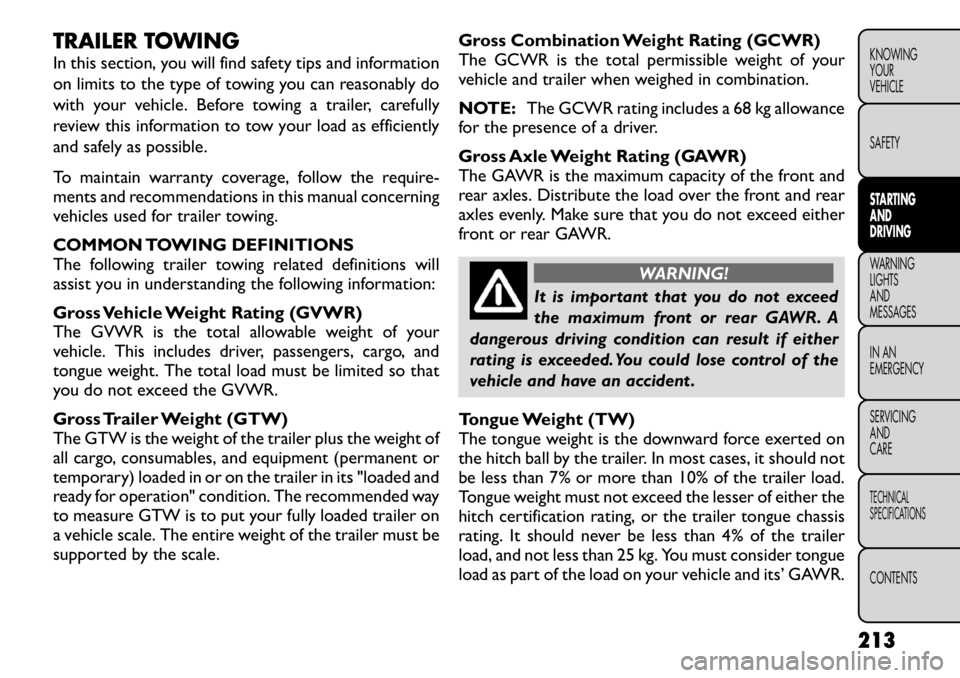
TRAILER TOWING
In this section, you will find safety tips and information
on limits to the type of towing you can reasonably do
with your vehicle. Before towing a trailer, carefully
review this information to tow your load as efficiently
and safely as possible.
To maintain warranty coverage, follow the require-
ments and recommendations in this manual concerning
vehicles used for trailer towing.
COMMON TOWING DEFINITIONS
The following trailer towing related definitions will
assist you in understanding the following information:
Gross Vehicle Weight Rating (GVWR)
The GVWR is the total allowable weight of your
vehicle. This includes driver, passengers, cargo, and
tongue weight. The total load must be limited so that
you do not exceed the GVWR.
Gross Trailer Weight (GTW)
The GTW is the weight of the trailer plus the weight of
all cargo, consumables, and equipment (permanent or
temporary) loaded in or on the trailer in its "loaded and
ready for operation" condition. The recommended way
to measure GTW is to put your fully loaded trailer on
a vehicle scale. The entire weight of the trailer must be
supported by the scale.Gross Combination Weight Rating (GCWR)
The GCWR is the total permissible weight of your
vehicle and trailer when weighed in combination.
NOTE:
The GCWR rating includes a 68 kg allowance
for the presence of a driver.
Gross Axle Weight Rating (GAWR)
The GAWR is the maximum capacity of the front and
rear axles. Distribute the load over the front and rear
axles evenly. Make sure that you do not exceed either
front or rear GAWR.
WARNING!
It is important that you do not exceed
the maximum front or rear GAWR. A
dangerous driving condition can result if either
rating is exceeded. You could lose control of the
vehicle and have an accident .
Tongue Weight (TW)
The tongue weight is the downward force exerted on
the hitch ball by the trailer. In most cases, it should not
be less than 7% or more than 10% of the trailer load.
Tongue weight must not exceed the lesser of either the
hitch certification rating, or the trailer tongue chassis
rating. It should never be less than 4% of the trailer
load, and not less than 25 kg. You must consider tongue
load as part of the load on your vehicle and its’ GAWR.
213
KNOWING
YOURVEHICLE SAFETYSTARTING ANDDRIVINGWARNING LIGHTSAND
MESSAGES
IN AN
EMERGENCY
SERVICING AND
CARETECHNICAL
SPECIFICATIONSCONTENTS
Page 220 of 332
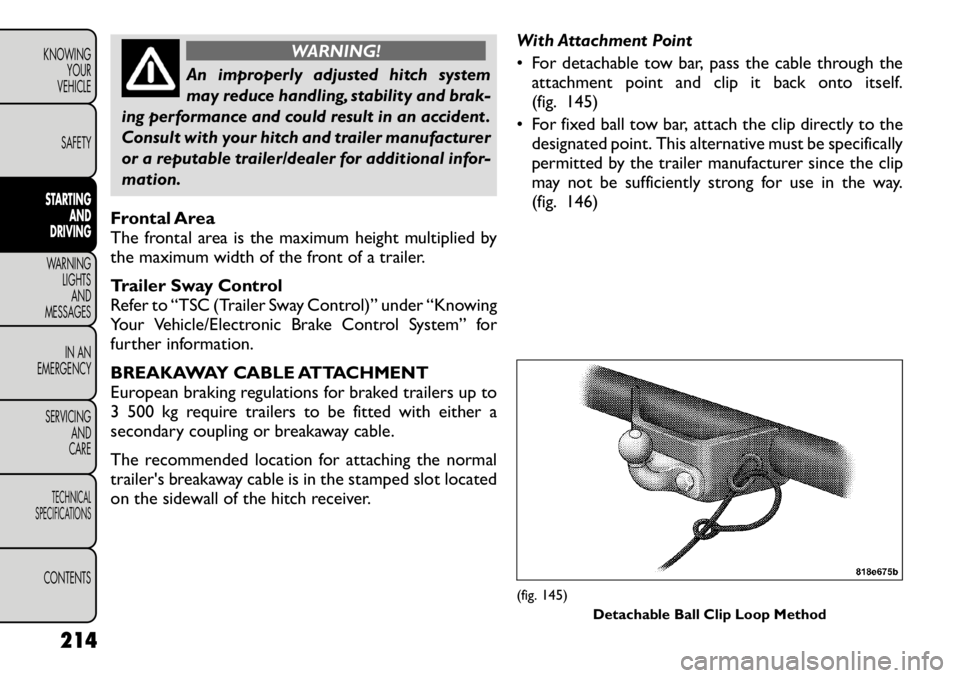
WARNING!
An improperly adjusted hitch system
may reduce handling, stability and brak-
ing performance and could result in an accident .
Consult with your hitch and trailer manufacturer
or a reputable trailer/dealer for additional infor-
mation.
Frontal Area
The frontal area is the maximum height multiplied by
the maximum width of the front of a trailer.
Trailer Sway Control
Refer to “TSC (Trailer Sway Control)” under “Knowing
Your Vehicle/Electronic Brake Control System” for
further information.
BREAKAWAY CABLE ATTACHMENT
European braking regulations for braked trailers up to
3 500 kg require trailers to be fitted with either a
secondary coupling or breakaway cable.
The recommended location for attaching the normal
trailer's breakaway cable is in the stamped slot located
on the sidewall of the hitch receiver. With Attachment Point
• For detachable tow bar, pass the cable through the
attachment point and clip it back onto itself.
(fig. 145)
• For fixed ball tow bar, attach the clip directly to the designated point. This alternative must be specifically
permitted by the trailer manufacturer since the clip
may not be sufficiently strong for use in the way.
(fig. 146)
(fig. 145)
Detachable Ball Clip Loop Method
214
KNOWING YOUR
VEHICLE
SAFETYSTARTING AND
DRIVINGWARNING LIGHTSAND
MESSAGES
IN AN
EMERGENCY
SERVICING AND
CARETECHNICAL
SPECIFICATIONSCONTENTS
Page 221 of 332

Without Attachment Points
• For detachable ball tow bar, you must follow therecommended manufacturer or supplier procedure.
(fig. 147)
• For fixed ball tow bar, loop the cable around the neck of the tow ball. If you fit the cable like this, use a single
loop only. (fig. 148)(fig. 146)
Fixed Ball Clip Loop Method
(fig. 147)Detachable Ball Neck Loop Method(fig. 148)
Fixed Ball Neck Loop Method
215
KNOWING
YOURVEHICLE SAFETYSTARTING ANDDRIVINGWARNING LIGHTSAND
MESSAGES
IN AN
EMERGENCY
SERVICING AND
CARETECHNICAL
SPECIFICATIONSCONTENTS
Page 222 of 332
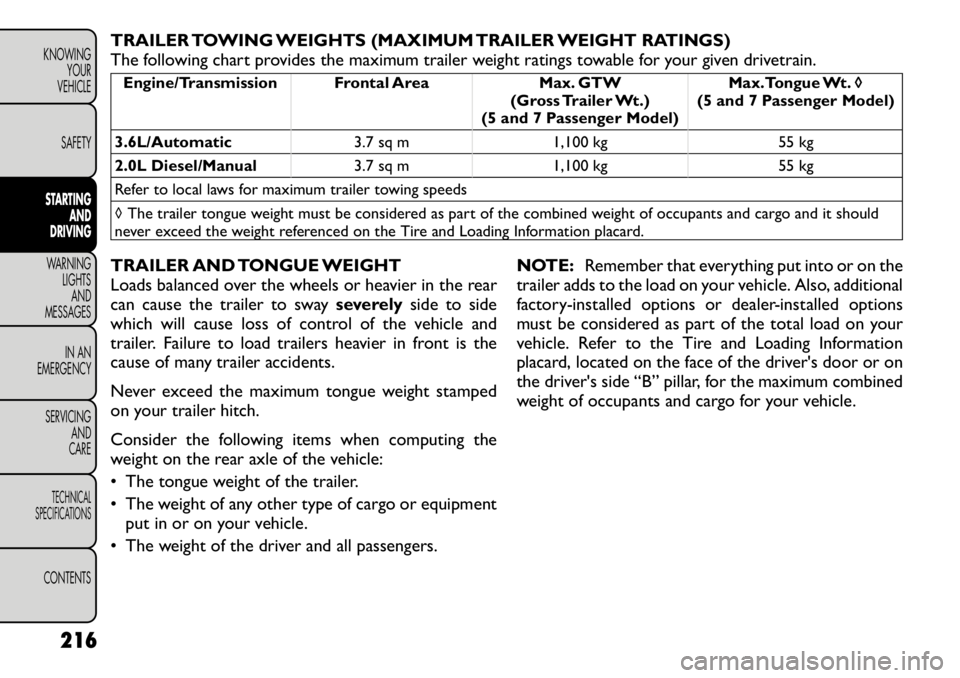
TRAILER TOWING WEIGHTS (MAXIMUM TRAILER WEIGHT RATINGS)
The following chart provides the maximum trailer weight ratings towable for your given drivetrain.Engine/Transmission Frontal Area Max. GTW(Gross Trailer Wt.)
(5 and 7 Passenger Model) Max.Tongue Wt. �
(5 and 7 Passenger Model)
3.6L/Automatic 3.7 sq m 1,100 kg 55 kg
2.0L Diesel/Manual 3.7 sq m 1,100 kg 55 kg
Refer to local laws for maximum trailer towing speeds
◊ The trailer tongue weight must be considered as part of the combined weight of occupants and cargo and it should
never exceed the weight referenced on the Tire and Loading Information placard.
TRAILER AND TONGUE WEIGHT
Loads balanced over the wheels or heavier in the rear
can cause the trailer to sway severelyside to side
which will cause loss of control of the vehicle and
trailer. Failure to load trailers heavier in front is the
cause of many trailer accidents.
Never exceed the maximum tongue weight stamped
on your trailer hitch.
Consider the following items when computing the
weight on the rear axle of the vehicle:
• The tongue weight of the trailer.
• The weight of any other type of cargo or equipment put in or on your vehicle.
• The weight of the driver and all passengers. NOTE:
Remember that everything put into or on the
trailer adds to the load on your vehicle. Also, additional
factory-installed options or dealer-installed options
must be considered as part of the total load on your
vehicle. Refer to the Tire and Loading Information
placard, located on the face of the driver's door or on
the driver's side “B” pillar, for the maximum combined
weight of occupants and cargo for your vehicle.
216
KNOWING YOUR
VEHICLE
SAFETYSTARTING AND
DRIVINGWARNING LIGHTSAND
MESSAGES
IN AN
EMERGENCY
SERVICING AND
CARETECHNICAL
SPECIFICATIONSCONTENTS
Page 223 of 332
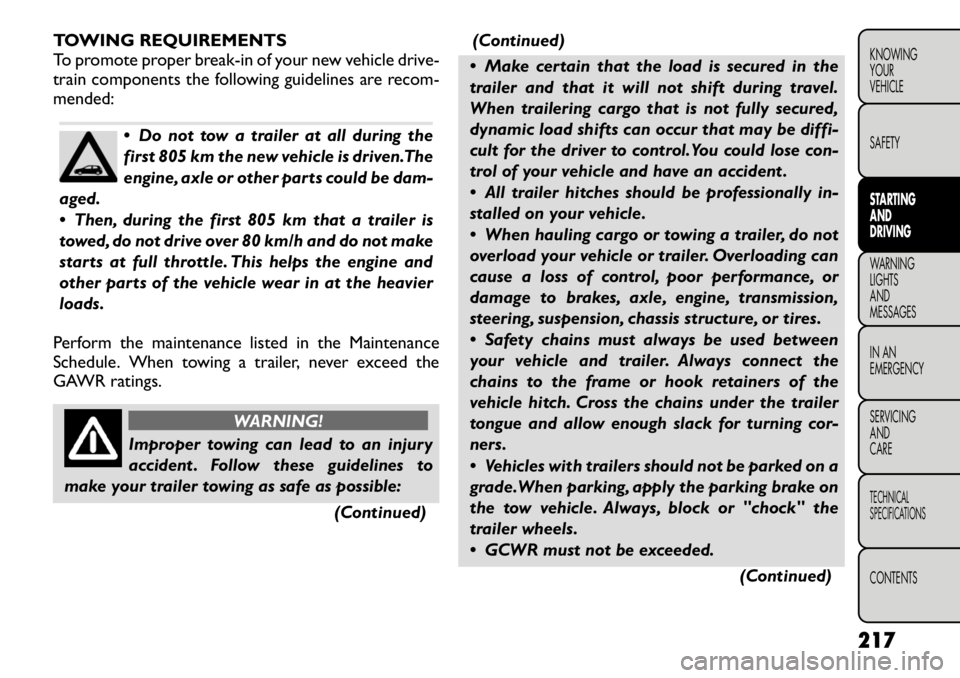
TOWING REQUIREMENTS
To promote proper break-in of your new vehicle drive-
train components the following guidelines are recom-mended:
Do not tow a trailer at all during the
first 805 km the new vehicle is driven.The
engine, axle or other parts could be dam-
aged.
Then, during the first 805 km that a trailer is
towed, do not drive over 80 km/h and do not make
starts at full throttle. This helps the engine and
other parts of the vehicle wear in at the heavier
loads.
Perform the maintenance listed in the Maintenance
Schedule. When towing a trailer, never exceed the
GAWR ratings.
WARNING!
Improper towing can lead to an injury
accident . Follow these guidelines to
make your trailer towing as safe as possible:
(Continued)(Continued)
Make certain that the load is secured in the
trailer and that it will not shift during travel.
When trailering cargo that is not fully secured,
dynamic load shifts can occur that may be diffi-
cult for the driver to control.You could lose con-
trol of your vehicle and have an accident .
All trailer hitches should be professionally in-
stalled on your vehicle.
When hauling cargo or towing a trailer, do not
overload your vehicle or trailer. Overloading can
cause a loss of control, poor performance, or
damage to brakes, axle, engine, transmission,
steering, suspension, chassis structure, or tires.
Safety chains must always be used between
your vehicle and trailer. Always connect the
chains to the frame or hook retainers of the
vehicle hitch. Cross the chains under the trailer
tongue and allow enough slack for turning cor-
ners.
Vehicles with trailers should not be parked on a
grade.When parking, apply the parking brake on
the tow vehicle. Always, block or "chock" the
trailer wheels.
GCWR must not be exceeded.
(Continued)
217
KNOWING
YOURVEHICLE SAFETYSTARTING ANDDRIVINGWARNING LIGHTSAND
MESSAGES
IN AN
EMERGENCY
SERVICING AND
CARETECHNICAL
SPECIFICATIONSCONTENTS
Page 224 of 332
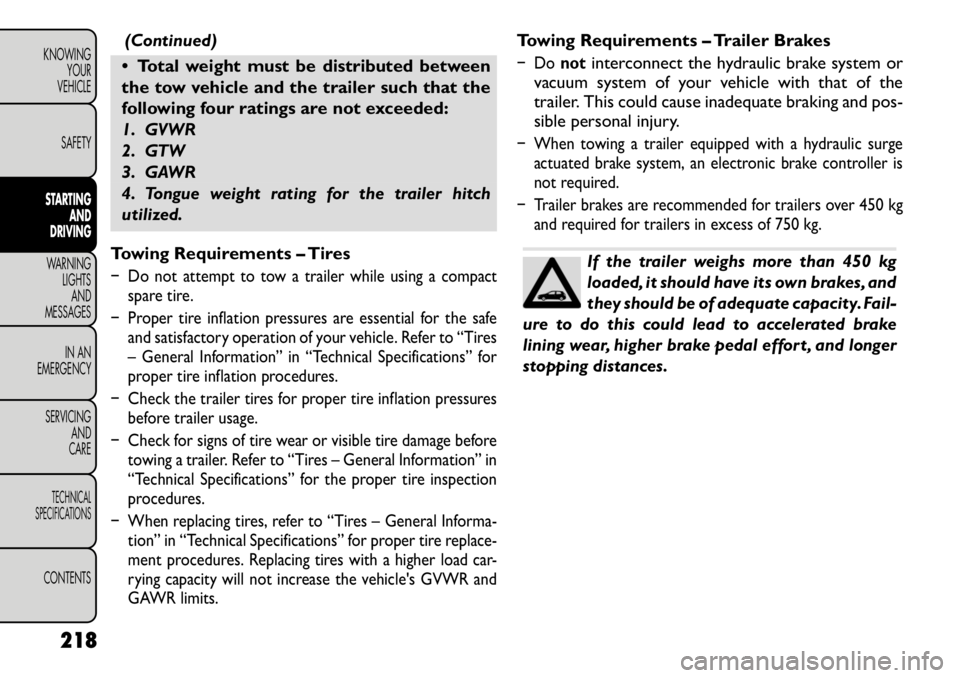
(Continued)
Total weight must be distributed between
the tow vehicle and the trailer such that the
following four ratings are not exceeded:
1. GVWR
2. GTW
3. GAWR
4. Tongue weight rating for the trailer hitch
utilized.
Towing Requirements – Tires� Do not attempt to tow a trailer while using a compact spare tire.
� Proper tire inflation pressures are essential for the safe and satisfactory operation of your vehicle. Refer to “Tires
– General Information” in “Technical Specifications” for
proper tire inflation procedures.
� Check the trailer tires for proper tire inflation pressures before trailer usage.
� Check for signs of tire wear or visible tire damage before towing a trailer. Refer to “Tires – General Information” in
“Technical Specifications” for the proper tire inspection
procedures.
� When replacing tires, refer to “Tires – General Inf orma-
tion” in “Technical Specifications” for proper tire replace-
ment procedures. Replacing tires with a higher load car-
rying capacity will not increase the vehicle's GVWR and
GAWR limits.
Towing Requirements – Trailer Brakes� Do not
interconnect the hydraulic brake system or
vacuum system of your vehicle with that of the
trailer. This could cause inadequate braking and pos-
sible personal injury.
� When towing a trailer equipped with a hydraulic surge actuated brake system, an electronic brake controller is
not required.
� Trailer brakes are recommended for trailers over 450 kg and required for trailers in excess of 750 kg.
If the trailer weighs more than 450 kg
loaded, it should have its own brakes, and
they should be of adequate capacity. Fail-
ure to do this could lead to accelerated brake
lining wear, higher brake pedal effort , and longer
stopping distances.
218
KNOWING YOUR
VEHICLE
SAFETYSTARTING AND
DRIVINGWARNING LIGHTSAND
MESSAGES
IN AN
EMERGENCY
SERVICING AND
CARETECHNICAL
SPECIFICATIONSCONTENTS
Page 225 of 332
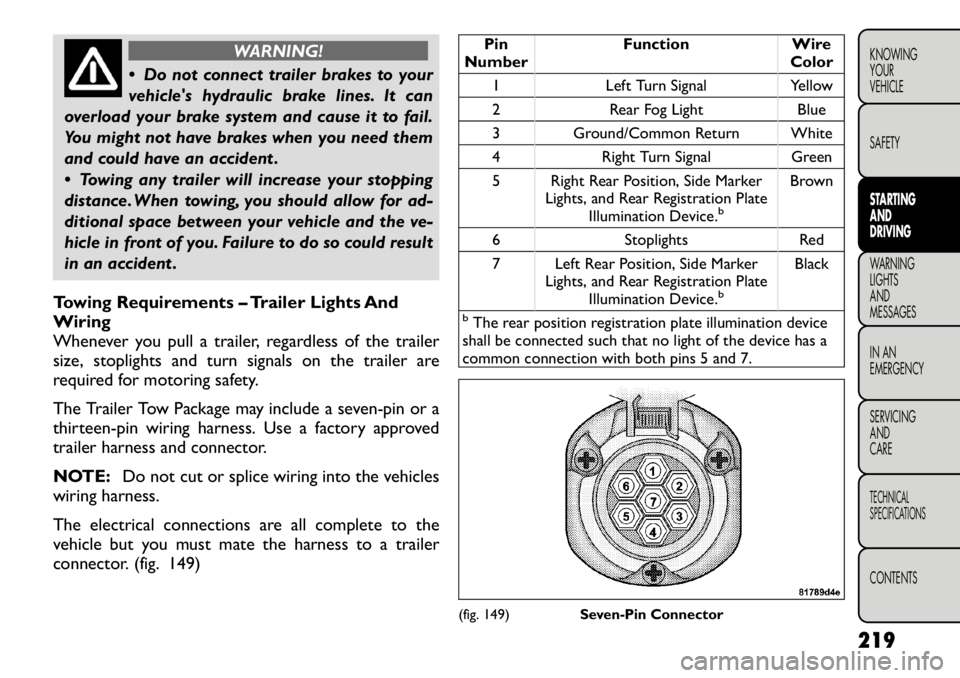
WARNING!
Do not connect trailer brakes to your
vehicle's hydraulic brake lines. It can
overload your brake system and cause it to fail.
You might not have brakes when you need them
and could have an accident .
Towing any trailer will increase your stopping
distance. When towing, you should allow for ad-
ditional space between your vehicle and the ve-
hicle in front of you. Failure to do so could result
in an accident .
Towing Requirements – Trailer Lights And
Wiring
Whenever you pull a trailer, regardless of the trailer
size, stoplights and turn signals on the trailer are
required for motoring safety.
The Trailer Tow Package may include a sev en-pin or a
thirteen-pin wiring harness. Use a factory approved
trailer harness and connector.
NOTE: Do not cut or splice wiring into the vehicles
wiring harness.
The electrical connections are all complete to the
vehicle but you must mate the harness to a trailer
connector. (fig. 149)
Pin
Number Function Wire
Color
1 Left Turn Signal Yellow
2 Rear Fog Light Blue
3 Ground/Common Return White
4 Right Turn Signal Green
5 Right Rear Position, Side Marker Lights, and Rear Registration PlateIllumination Device.
b
Brown
6 Stoplights Red
7 Left Rear Position, Side Marker Lights, and Rear Registration PlateIllumination Device.
b
Black
bThe rear position registration plate illumination device
shall be connected such that no light of the device has a
common connection with both pins 5 and 7.(fig. 149) Seven-Pin Connector
219
KNOWING
YOURVEHICLE SAFETYSTARTING ANDDRIVINGWARNING LIGHTSAND
MESSAGES
IN AN
EMERGENCY
SERVICING AND
CARETECHNICAL
SPECIFICATIONSCONTENTS
Page 226 of 332
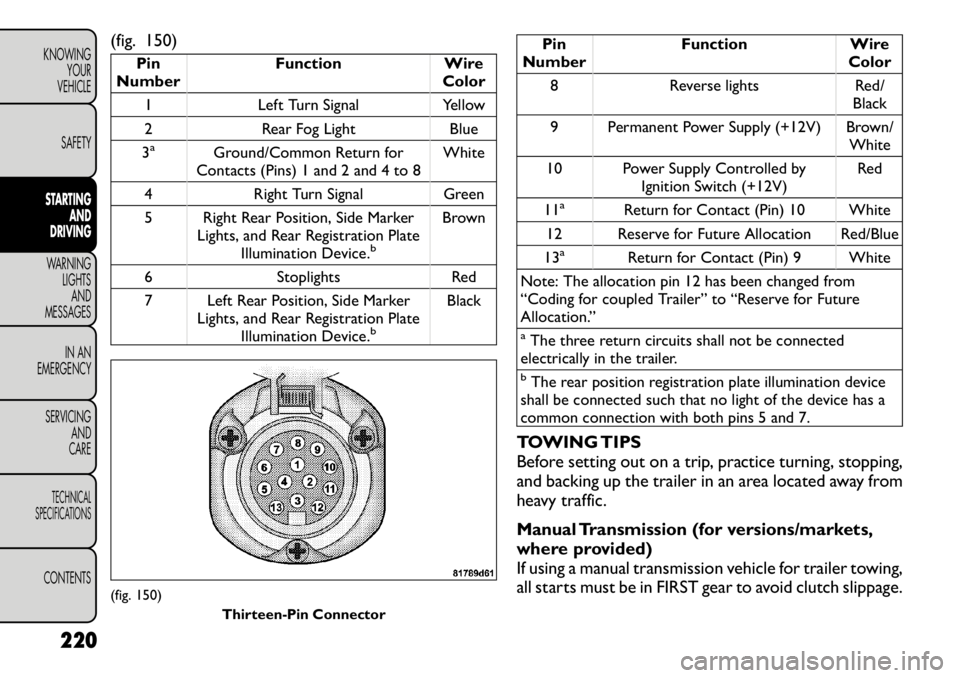
(fig. 150)
Pin
Number Function Wire
Color
1 Left Turn Signal Yellow
2 Rear Fog Light Blue
3a
Ground/Common Return for
Contacts (Pins) 1 and 2 and 4 to 8 White
4 Right Turn Signal Green
5 Right Rear Position, Side Marker Lights, and Rear Registration PlateIllumination Device.
b
Brown
6 Stoplights Red
7 Left Rear Position, Side Marker Lights, and Rear Registration PlateIllumination Device.
b
Black
Pin
Number Function Wire
Color
8 Reverse lights Red/ Black
9 Permanent Power Supply (+12V) Brown/ White
10 Power Supply Controlled by Ignition Switch (+12V) Red
11
a
Return for Contact (Pin) 10 White
12 Reserve for Future Allocation Red/Blue
13
a
Return for Contact (Pin) 9 White
Note: The allocation pin 12 has been changed from
“Coding for coupled Trailer” to “Reserve for Future
Allocation.”
aThe three return circuits shall not be connected
electrically in the trailer.bThe rear position registration plate illumination device
shall be connected such that no light of the device has a
common connection with both pins 5 and 7.
TOWING TIPS
Before setting out on a trip, practice turning, stopping,
and backing up the trailer in an area located away from
heavy traffic.
Manual Transmission (for versions/markets,
where provided)
If using a manual transmission vehicle for trailer towing,
all starts must be in FIRST gear to avoid clutch slippage.
(fig. 150) Thirteen-Pin Connector
220
KNOWING YOUR
VEHICLE
SAFETYSTARTING AND
DRIVINGWARNING LIGHTSAND
MESSAGES
IN AN
EMERGENCY
SERVICING AND
CARETECHNICAL
SPECIFICATIONSCONTENTS
Page 227 of 332
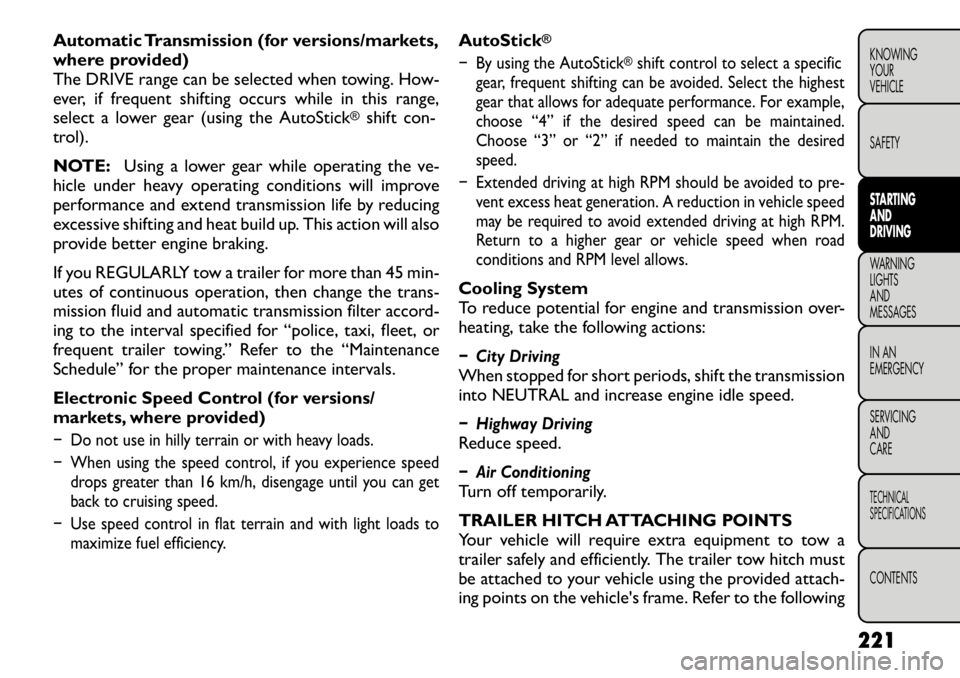
Automatic Transmission (for versions/markets,
where provided)
The DRIVE range can be selected when towing. How-
ever, if frequent shifting occurs while in this range,
select a lower gear (using the AutoStick
®
shift con-
trol).
NOTE: Using a lower gear while operating the ve-
hicle under heavy operating conditions will improve
performance and extend transmission life by reducing
excessive shifting and heat build up. This action will also
provide better engine braking.
If you REGULARLY tow a trailer for more than 45 min-
utes of continuous operation, then change the trans-
mission fluid and automatic transmission filter accord-
ing to the interval specified for “police, taxi, fleet, or
frequent trailer towing.” Refer to the “Maintenance
Schedule” for the proper maintenance intervals.
Electronic Speed Control (for versions/
markets, where provided)
� Do not use in hilly terrain or with heavy loads.
� When using the speed control, if you experience speed drops greater than 16 km/h, disengage until you can get
back to cruising speed.
� Use speed control in flat terrain and with light loads to maximize fuel efficiency.
AutoStick
®
� By using the AutoStick
®shift control to select a specific
gear, frequent shifting can be avoided. Select the highest
gear that allows for adequate performance. For example,
choose “4” if the desired speed can be maintained.
Choose “3” or “2” if needed to maintain the desiredspeed.
� Extended driving at high RPM should be avoided to pr e-
vent excess heat generation. A reduction in vehicle speed
may be required to avoid extended driving at high RPM.
Return to a higher gear or vehicle speed when road
conditions and RPM level allows.
Cooling System
To reduce potential for engine and transmission over-
heating, take the following actions:� City DrivingWhen stopped for short periods, shift the transmission
into NEUTRAL and increase engine idle speed.� Highway DrivingReduce speed.� Air ConditioningTurn off temporarily.
TRAILER HITCH ATTACHING POINTS
Your vehicle will require extra equipment to tow a
trailer safely and efficiently. The trailer tow hitch must
be attached to your vehicle using the provided attach-
ing points on the vehicle's frame. Refer to the following
221
KNOWING
YOURVEHICLE SAFETYSTARTING ANDDRIVINGWARNING LIGHTSAND
MESSAGES
IN AN
EMERGENCY
SERVICING AND
CARETECHNICAL
SPECIFICATIONSCONTENTS